Press Kit



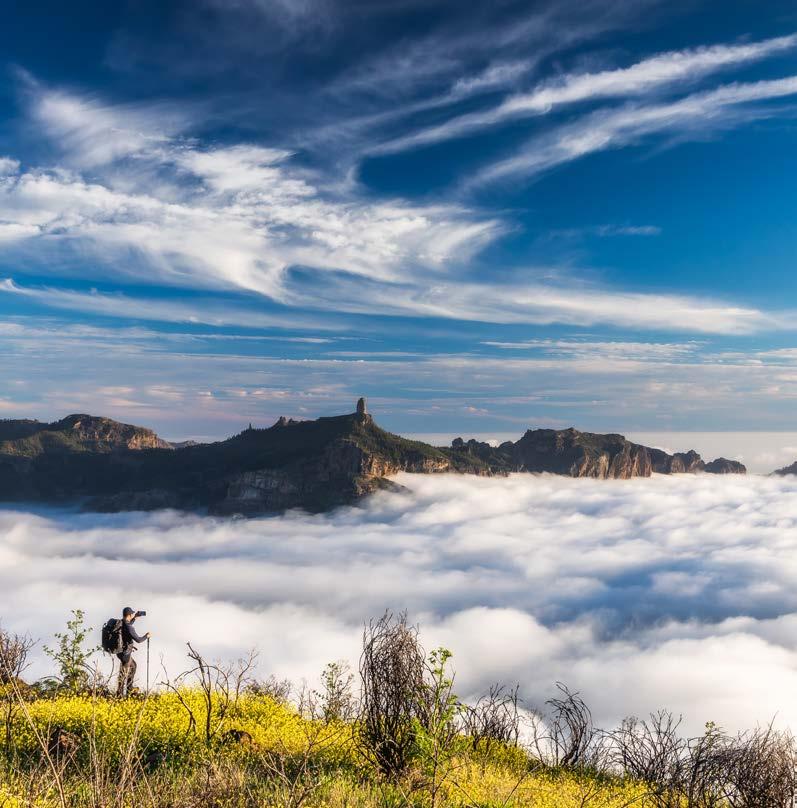
Gran Canaria is an island located in the Atlantic Ocean, at the geographical coordinates 27º 58’ N 15º 36’ W. It stands 210 km from the nearest point of Africa and 1.250 km from Cádiz. Within the Canary archipelago, Gran Canaria is situated between Fuerteventura, 83 km to the east, and Tenerife, 62 km to the west.
Gran Canaria is of volcanic origin and has a surface area covering 1.560 km2 as well as 236 km of coastline, representing the great variety of landscapes of the Canary Islands. Because of this characteristic and its huge variety of microclimates, it is known as a
Gran Canaria
GEOGRAPHICAL COORDINATES
27º 58’ N 15º 36’ W
«miniature continent». Pico de los Pozos de Las Nieves, in the centre of the island, is its highest peak, standing at 1.949 m. From its summit, with the Roque Nublo as the island’s symbol, down to the coast, its geography is radially furrowed by deep ravines that contain landscapes of strong and amazingly beautiful contrasts.

Gran Canaria is linked by air to the main airports in Spain, Europe and West Africa. It is the perfect destination for holidays and breaks thanks to its proximity, excellent connectivity, European quality standards and standard of living.
Gran Canaria International Airport (LPA) is located at a distance of 18 km from the island’s capital, Las Palmas de Gran Canaria, and 25 km from the tourist resorts in the south. It is connected to 167 airports and is directly linked to 29 countries.
GRAN CANARIA - MADRID
1.765.05 km 2 h 42 min
GRAN CANARIA - LONDON (GATWICK)
2.876.61 km 04 h 05 min
GRAN CANARIA - BERLIN
3.617.54 km 5 h
Airline seat forecasts for travel to Gran Canaria in the coming months of 2025
Map of air connections


Gran Canaria is a key centre in the Atlantic, and represents a bridge between Europe, Africa and America. Its main infrastructure, the Port of Las Palmas, belongs to the network of ports of general interest in Spain, offering safety and competitiveness, with sustained growth in all its traffic.
It is the most important port in the Canary Islands, the leading port in the Mid-Atlantic and one of the five major ports in Spain,
Port traffic in Gran Canaria 2024
both in terms of traffic volume and the diversity of operations it manages (repairs, supplies, provisioning, transit, passengers and cruises).
It is the base of operations for numerous offshore energy companies, mining companies and the distribution of emergency and humanitarian resources, such as the World Food Programme and the Red Cross.
Port data for 2024
PASSENGERS 2.371.619
GOODS TRANSPORTED (TONS) 27,5 millones
Stopovers 11.669
Containers (TEU) 1.210.809
Bunkering 2.868.270
Connectivity 152 countries
Port data
The Port of Las Nieves (Agaete), part of the Canary Islands Ports network, handled an accrued total of 1,178,388 passengers in 2024.
The Port of Las Palmas de Gran Canaria regularly operates with over 30 African countries in more than 70 ports
where luxury and authenticity come together in its extraordinary range of accommodation.
Gran Canaria is a top tourist destination, not only for its stunning beaches, landscapes, and year-round warm climate, but also for its extraordinary range of accommodation, designed to meet the needs of all visitors.
Hotels and beach resorts, flats and aparthotels, villas, and rural accommodation, including even cave houses in the municipalities that form part of the Gran Canaria Biosphere Reserve. A wide range of possibilities that stand out for their quality and in which the renovation of the establishments has been a constant in recent years, meeting the new tourist standards and responding to the highest demands.
The hotel and extra-hotel establishments in Gran Canaria offer a total of 194.681 beds in their different categories. The tourist business of Gran Canaria has opted for differentiation and for adding attractions to the island’s extensive tourist offer. Its services and infrastructures have been geared towards the sustainable development of its tourist activity in order to ensure the sustainability of its resources, an essential step towards a more responsible future.
Gran Canaria consolidates in 2025 its position as the leading island in sustainability within the archipelago, having the largest number of companies certified by the Responsible Tourism Institute (ITR) with its prestigious Biosphere seal. Additionally, it ranks the second Biosphere destination with the most certifications in all of Spain, surpassed only by Barcelona. This recognition is the result of the island’s commitment to a more responsible tourism model, driven through various public and private initiatives that reinforce its aim to achieve
a more sustainable and environmentally respectful future.
Gran Canaria’s accommodation offer includes luxury hotels in iconic tourist areas on the coast such as Maspalomas, Playa del Inglés, Mogán, or in its cosmopolitan capital, Las Palmas de Gran Canaria, where the number of luxury boutique hotels has increased steadily in recent years. These are establishments that pay the utmost attention to detail to guarantee a unique experience, many of them focused on concepts such as wellness, health, and beauty. The range of establishments included in the wellness category is innumerable and contributes to maintaining Gran Canaria’s prestige in terms of health and relaxation with numerous spa and thalassotherapy centres in which to pamper body and mind.
Gran Canaria also offers the combination of a magnificent hotel and a restaurant with a MICHELIN Star restaurant, adding an unforgettable gastronomic experience to a luxury stay.
The wide range of accommodation on this «miniature continent» also includes apartment complexes and aparthotels in unbeatable locations and with every comfort, the best option for travellers who want to have their own functional space during their stay.
And in its charming inland villages: hotels, rural houses, and villas - in addition to the aforementioned cave-houses - allow you to connect with the essence of Gran Canaria’s nature and immerse yourself in its most deeply rooted traditions. Located in dream locations for lovers of tranquillity and relaxation, most of them are surprising for the traditional Canarian architecture of the buildings, guardians of the island’s identity.
Many of the destination’s accommodations are highly specialised in catering for sportsmen and women. Gran Canaria is an ideal destination for lovers of sport and active tourism due to its nature, special orography and mild climate that allows outdoor sports to be practised at any time of the year. For them, their companions and families, the destination offers the best accommodation with services associated with a wide range of sporting activities in which to combine rest and recuperation. Choosing the island to take on any sporting challenge means finding a wide network of hotels and flats fully equipped with heated swimming pools, hot tubs, fitness circuits and sports recovery centres.

Gran Canaria: Population 863,943.
SANTA
SAN BARTOLOMÉ DE TIRAJANA
LAS
This municipality is catalogued as having the highest number of sunny days in the whole of Spain.
Thanks to its privileged geographical location, the generosity of the trade winds and the Azores anticyclone, the average annual temperature on Gran Canaria is 24 degrees
The average temperature ranges from 18°C in winter to 25°C in summer, and the island maintains a pleasant climate in all seasons, with approximately 3,000 hours of sunshine per year, thanks to its subtropical climate, making it one of the places with the most sunlight hours in Europe.
The island’s diversity of microclimates is striking, with temperatures varying by several degrees depending on the area of the island. It is possible to enjoy the sun and the sea at any time of the year and feel the contrast in temperature as you head to the heart of the island, with natural wonders such as the laurel forests or the centuriesold pine forests that contrast with the lush palm groves.
Las Palmas de Gran Canaria: Population 380,436, the 9th most populated city in Spain.
Weight of Las Palmas de Gran Canaria’s population in the total of Gran Canaria: 44.17%, the city with the largest population in the Canary Islands.
POPULATION
380.436
Las Palmas de Gran Canaria
863.943
Gran Canaria
1. A diversity of landscapes all within a short distance of one another, a «miniature continent».
2. A unique lifestyle with its own cultural expressions, together with an excellent quality of life.
3. Extensive variety of complementary tourist products to ‘sun and beach’. Diverse activities and experiences.
4. Hospitality and security, in the broadest sense of the word, that meet the strictest European quality standards.
5. Connections and infrastructure. Excellent air, sea, and digital connectivity, as well as top-level hotel infrastructure, many of which have undertaken significant transformation and rehabilitation projects focused on implementing sustainability criteria as a central axis.


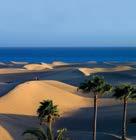
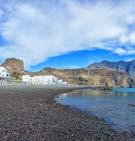
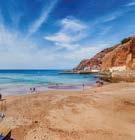

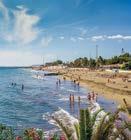
128 sunny beaches in both winter and summer, with crystal clear waters and fine golden sand or dark volcanic sand. Quiet coves where visitors can lose themselves and natural pools that look out over the Atlantic, flanked by spectacular ravines. Most of them offer on-site facilities all year round, making them safe and convenient for all members of the family, with nature-induced transparent waters providing relaxation and enjoyment.
They range from Las Canteras beach, considered one of the best urban beaches in the world, to the southern beaches, with Maspalomas and its iconic Dune Reserve as its flagship.
• Maspalomas
• Las Canteras
• Playa del Inglés
• Puerto Rico
• Mogán
• Amadores
• Agaete
• Meloneras
• San Agustín
known, unspoilt and wild beaches
• Guguy (La Aldea de San Nicolás)
• Guayedra (Agaete)
• Aguadulce (Telde)
• El Cabrón (Agüimes)
SARDINA
LAS NIEVES
MOGÁN
EL PUERTILLO
LOS CHARCONES LAS CANTERAS
LA GARITA HOYA DEL POZO MELENARA SALINETAS
EL BURRERO
ARINAGA
EL INGLÉS
Gran Canaria boasts 14 Blue Flag awards for beaches, 2 awards for Sports Marinas, and 2 Blue Centers. This seal distinguishes the beaches and marinas that meet criteria of excellence in bathing water quality, comply with environmental regulations and have health and safety infrastructure to ensure the health and safety of their users.
AGAETE Las Nieves
AGÜIMES Arinaga
ARUCAS El Puertillo Los Charcones
GÁLDAR Sardina
INGENIO El Burrero
SAN BARTOLOMÉ DE TIRAJANA El Inglés Maspalomas Meloneras
San Agustín
TELDE Hoya del Pozo La Garita Melenara Salinetas
• Tiritaña (Mogán)
• Punta de Las Arenas (Artenara)
Natural pools by the seashore, set among volcanic rocks, and inland crystalline pools
• La Furnia (Gáldar)
• Roque Prieto (Guía)
• Las Salinas (Agaete)
• El Charco de San Lorenzo (Villa de Moya)
• El Charco Azul (entre La Aldea de San Nicolás y Agaete)
• El Charco de La Paloma (Tejeda)
Marinas with Blue Flag in Gran Canaria
MOGÁN
Mogán Sports Marina
SAN BARTOLOMÉ DE TIRAJANA
Pasito Blanco Sports Marina
The 2 Gran Canaria distinctions as a Blue Centre reward, in municipalities with Blue Flag beaches, the existence of a visitor centre, a sea or nature centre that includes among its objectives and activities environmental education on coastal ecosystems and sustainable development.
The Interpretation Center of the Natural “Reserve of the Dunes of Maspalomas”.
The Educational Room of the Tony Gallardo Park “Reserve of the Oasis of Maspalomas.”


Roque Nublo is the geographical landmark with the greatest symbolic value on these lands.
This rock is a natural monument that forms part of the protected areas of Gran Canaria. Surrounded by the Nublo Rural Park, it is one of the largest rocks in the world, standing 1.813 m above sea level. It is a volcanic monolith that rises up almost 90 metres high from its base, and is part of the Gran Canaria World Biosphere Reserve, located in the municipality of Tejeda, the latter listed as one of the most beautiful villages in Spain, and presiding over one of the largest calderas on the island, the caldera of Tejeda.
In addition to the majesty of the landscape that lies all around, surrounded as it is by pine forests offering a 360º view, it is also the best place to observe the curious floating “sea of clouds” phenomenon that occurs in the Canary Islands and which seems to submerge this sacred space for the people of Gran Canaria and the neighbouring Pico del Teide in cotton wool.
From February 3, 2025, access to the Roque Nublo trail will require previous booking during peak hours (9:00 AM to 5:00 PM) as part of measures to promote sustainability and conserve this icon of Gran Canaria. Reservations will be available from January 15 on www.grancanariasenderos.com. The system includes QR code controls and shuttle buses from nearby parking lots, ensuring a sustainable and quality experience.

The Reserve stretches out over 403.9 hectares of sand dunes and contains the Charca de Maspalomas, a pond that lies in an area of high ecological value, serving as a nesting centre for birds.
This natural environment is well preserved, considering that it is one of the most visited areas of the island and constitutes a real scenic jewel. Both the flora and the birds that inhabit or visit the wetlands in this area, are protected by national and regional laws.
The Charco de Maspalomas pond is home to an abundance of species that represent the rich biodiversity of the ecosystems of Gran Canaria, and are unique in the world. It is of scientific interest because of its geomorphological and geological elements that make up a unique landscape.
Nature is present in every corner of Gran Canaria, but the local flora holds pride of place at the “Viera y Clavijo” Botanical Garden, or Jardín Canario, which brings together all the botanical wealth of the islands in a single space.
The garden houses a centre dedicated to the research, conservation and management of the terrestrial flora of the Canary Islands, the Macaronesia region as well as specimens from different areas of the planet related to this region. It is the largest botanical garden in Spain, and one of the finest in the world. Located on the edge of the Guiniguada ravine, in Las Palmas de Gran Canaria, it spreads out over 27 hectares that are home to exotic plant species and more than 500 endemic plants, some in danger of extinction, with thousands of cacti, dragon trees and palm trees distributed throughout the main areas into which this open-air enclosure is divided. The birds that live or visit the wetlands of this space are protected by national and regional laws.
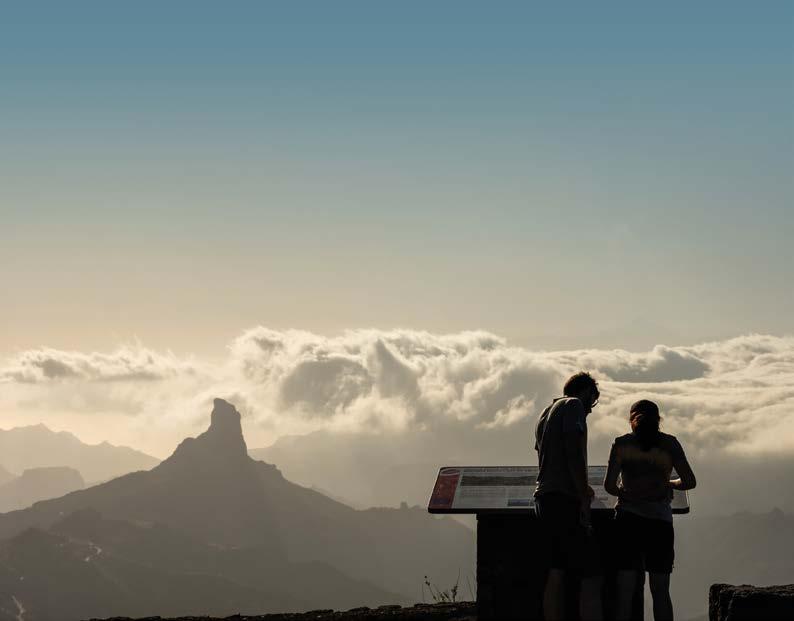
La Sorrueda
El Ingenio
Las Tederas
El Guriete
Presa de Los Hornos
Caldera de los Marteles
La Crucita
Roque Bentayga
El Mulato
La Cruz Grande
Bandama
Pinos de Gáldar
Roque Nublo
Pico de los Pozos de la Nieve
Degollada Becerra
Plaza de San Roque
AGAETE
GÁLDAR
ARTENARA
TEJEDA
SANTA MARÍA DE GUÍA
MOYA
Las Pellas
Degollada de las Palomas
Degollada de las Yeguas
Barranco Las Madres
Barranco de Azuaje
Montaña de Arucas
Marquesa de Arucas
Las Canteras (Arucas)
Andén Verde
Inagua
Playa de La Garita
Punta del Castellano
Paseo de Taliarte
Playa de Salinetas
Playa de Tufia
Punta del Castellano, Taliarte
FIRGAS
ARUCAS
TEROR
VALLESECO
SAN MATEO
LAS PALMAS DE GRAN CANARIA
SANTA BRÍGIDA
VALSEQUILLO DE GRAN CANARIA
TELDE
LA ALDEA DE SAN NICOLÁS
MOGÁN
SAN BARTOLOMÉ DE TIRAJANA
SANTA LUCÍA
INGENIO
AGÜIMES
TOTAL TOURISTS GRAN CANARIA (FRONTUR) 4.716.204
FOREIGN PASSENGERS 4.165.838
AVERAGE DAYS’ STAY 7,3 days
AVERAGE DAILY RATE (ADR) 123,47 €
OVERNIGHT STAYS Annual total
27.934.940 TRAVELLERS IN ACCOMMODATION
3.923.372
OCCUPANCY RATE By rooms: 81,49 By beds: 71,4
EXPENDITURE
1.493,54€
Air connectivity for Gran Canaria 2024-2025
Airports 167 Countries 29
Airline companies 61
Protected surface area 65.994,42 he
42,3% of the island
Marine strip 37.600.14 he
Gran Canaria has been the recipient of important awards that reflect the high degree of conservation of its natural and cultural heritage. These include the highest status of its kind recognised in the world, that of UNESCO Biosphere Reserve, a declaration that joins the addition of Risco Caído and the Montaña Sagrada to the list of World Heritage Sites. The UNESCO has also certified the island as a Starlight Tourist Destination, due to its commitment to ensuring the quality of the night sky and access to starlight.
These three levels of protection and recognition are in addition to the large number of protected natural spaces that exist in Gran Canaria. Despite its small surface area, the island boasts a natural heritage of enormous value, represented in the uniqueness of its ecosystems, fauna, flora and geology.
The island was declared a Biosphere Reserve in 2005 thanks to its natural, cultural and ethnographic assets. This territory is noted for its geological formations, its extensive pine forests and its high biodiversity, both in terms of its flora and its fauna.
The area is also home to an important cultural wealth, which is evidenced by the multitude of archaeological sites. The population developed an important primary activity, which gave rise to important traditional settlements.
This area protected totals 65.994.42 hectares of land, representing more than 40% of the island’s total surface area, covering 7 municipalities and a wide marine strip of 37.600.14 ha, which occupies 34.7% of the reserve’s area.
Territorial zoning is a significant feature of the Biosphere Reserve concept. In order to ensure the economic and social development of its population, in balance
Integral Nature Reserve
Special Nature Reserve
Natural Park
Rural Park
Natural Monument
Protected Landscape Site of Scientific Interest
with natural and cultural values, the reserve is based on three basic zones: core zone, buffer zone and transition zone.
This is made up of the Inagua Integral Nature Reserve and the Guguy Special Nature Reserve and its function is based, fundamentally, on the conservation of natural values.
This is made up of the Tamadaba Natural Park, the Pilancones Natural Park, Nublo Rural Park and a small marine strip covering an area of 250 hectares.
This occupies the rest of the reserve’s territory, in which more than 80% of its population is located.
The United Nations Educational, Scientific and Cultural Organisation (UNESCO) recognised, on 7th July 2019, the Outstanding Universal Value of the Cultural Landscape of Risco Caído and Montañas Sagradas de Gran Canaria.
Risco Caído and Montañas Sagradas de Gran Canaria are part of a group of unique expressions in the heart of the colossal Caldera de Tejeda, occupying an extensive mountainous area in the centre of the island. The cultural landscape is made up of cliffs, ravines and volcanic formations in a landscape boasting rich biodiversity. It includes a large number of troglodyte settlements, habitats, granaries and cisterns, the antiquity of which proves the presence of a pre-Hispanic culture on the island that evolved in isolation, from the arrival of the North African Berbers, the beginning of our era, through to the arrival of the first Spanish settlers in the 15th century. The complex contains cult cavities and two sacred temples or almogarenes, namely Risco Caído and the Roque Bentayga, ceremonial spaces linked to the worship of the stars and “Mother Earth”.
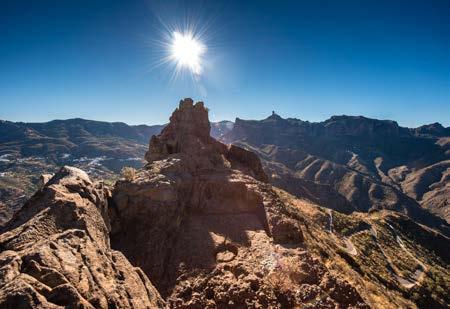
The Cultural Landscape of Risco Caído and the Sacred Mountains of Gran Canaria features three interpretation centers that allow visitors to delve into its historical and cultural value.
Interpretation Center of Risco Caído.
Interpretation Center of Roque Bentayga.
Management and Information Center of the Cultural Landscape Risco Caído and the Sacred Mountains.

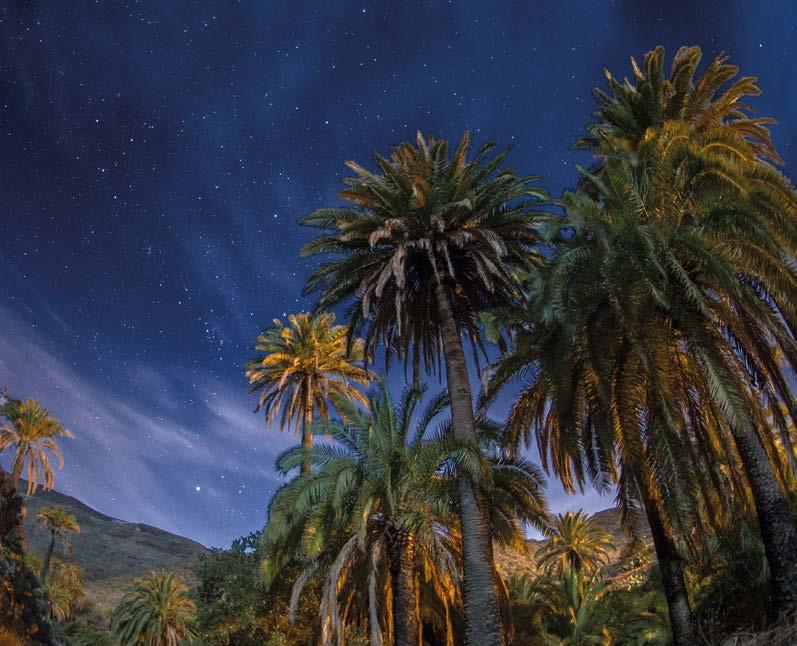
In February 2018, UNESCO listed Gran Canaria as a Starlight Tourist Destination, due to the quality of its skies for astronomical observation. The island forms part of the world’s select club of destinations that are particularly attractive for astro-tourism. Because of its privileged geographical position, it is possible to observe the skies of the southern hemisphere, with almost 80% of it being visible, which makes it possible for constellations and celestial objects that are normally visible to be seen from only a very few places around the world
Gran Canaria is working hand in hand with the Starlight Foundation and the United Nations in the Defence of the Night Sky and the Right to Starlight. The island is equipped with resources, products,
services and qualified tourism professionals that contribute to the protection and dissemination of this common, universal and scarce resource, which also promotes sustainable and responsible development associated with the vision of the sky in local communities.
The island is home to 11 sites of scenic interest that have special atmospheric and physical conditions for astronomical study and the development of astrotourism activities. They come in the form of strategically located balconies overlooking infinity with spectacular views.
Gran Canaria is the perfect natural observatory for contemplating the Universe.
The best observation points are to be found at the highest altitudes, above 1,800 metres, such as the vantage point offered by the Pico de las Nieves viewpoint, at 1.938 metres, the Llanos del Garañón, in Tejeda, or the Roque Saucillo Astronomy Centre, in Vega de San Mateo. These are joined by the Temisas Astronomical Observatory, in Agüimes, and the Tasartico Astronomical Observatory, located among the incredible ravines of La Aldea de San Nicolás.
Altitude: 1.938 metres
Astronomical Viewpoint of Pico de los Pozos de la Nieve at 1,938 meters high.
Gran Canaria holds the Biosphere Destination certification, a distinction that recognizes the destination’s efforts in sustainability.


investment and businesses. It aims to protect the environment and to promote the conservation of natural areas, reducing the environmental impact of tourism in the destination.
As part of its commitment to sustainability, Gran Canaria has worked to have the destination become a member of the global Biosphere Destination Community, an initiative of the Responsible Tourism Institute (RTI) which promotes a certification system based on the principles of the World Charter for Sustainable Tourism. This initiative requires the crosscutting collaboration of administrations and of all the stakeholders of the destination’s tourism industry in order to achieve a responsible tourism system in which the local community plays an essential role.
Through this sustainability management program, 55 companies in Gran Canaria have obtained the certification that validates their efforts in this area. As of early 2025, the program involves 109 companies on the island, of which 81 are in the COMMITTED category, while the 55 mentioned have achieved the CERTIFIED level after successfully completing the process through the online Biosphere Sustainable Lifestyle platform. This management tool, made available to the sector by Gran Canaria Tourist Board, facilitates the alignment of the destination’s tourism model with sustainability principles.
• Gran Canaria is the first island in the archipelago to have an “Island strategy for adaptation to climate change and promotion of a lowcarbon economy”, an initiative that places the island at the forefront in the Canary Islands in the fight against global warming. Based on these advances, Gran Canaria is the only island in the archipelago selected for the European Union’s Mission for Adaptation to Climate Change
Gran Canaria understands sustainability in a fully global context. It strives to be a sustainable destination in economic, environmental and socio-cultural terms. By meeting these three criteria, tourism can become a driver of change for ecological transition.
These are fairs that encourage the promotion of local products and producers. They come in the form of traditional markets that are held in different municipalities around the island. In addition to rediscovering these locations, they enable visitors to learn about and purchase quality products that have not been transported long distances, and which help to boost the local economy. They are products that contribute to the maintenance of the landscape and the preservation of the territory, its customs and traditions, some of which date back centuries. The consumption of Km.0 or locally-sourced products is a way of forging a more sustainable world and fostering fairer trade.
More than 335 producers from Gran Canaria have participated in nearly 30 editions of this initiative, which highlights local agri-food products.
Upcoming Km.0
(Locally Source Products) Fairs Confirmed:
March 8-9: San Bartolomé de Tirajana - Football Field 3, Parque Sur, Maspalomas.
March 22-23: Las Palmas de Gran Canaria - Elder Museum of Science and Technology.
June 7-8: Arucas - Parque de Las Flores.
August 16-17: Villa de Moya, Fontanales.
Gran Canaria continues to take steps in order to become an increasingly sustainable destination, focusing on the three pillars of sustainability: socioeconomic, environmental and territorial, in line with the Sustainable Development Goals (SDGs) and the United Nations 2030 Agenda.
The joint efforts made by public and private entities in the field of tourist sustainability have resulted in Gran Canaria having received the Biosphere Destination certification. This international seal positions the island as a prominent member of the global Biosphere Destination Community.
Gran Canaria promotes sustainability as a crosscutting element of its growth.
The destination aims to achieve a sustainable growth model, aligned with the SDGs, that benefits the local community, tourists,
• Gran Canaria Tourism promotes different actions to achieve an increasingly sustainable destination, including the search for a positive effect of tourism on society, the development of SMEs in the industry and the promotion of sustainable tourism among islanders and tourists. This strategy includes encouraging companies to adopt good environmental practices through awarenessraising and information projects. In line with this, support for events held on the island must be aligned with these approaches, and must serve the public good, with the environment being one of the main values to be protected.
• On 24th October 2022, Gran Canaria officially signed up to the Glasgow Climate Pact for the decarbonisation of the tourism industry, a United Nations initiative that obliges the sector to reduce CO2 emissions by 50% within eight years.
The forests around the summit of Gran Canaria have gained international recognition for their sustainable forest management. Specifically 17.030.58 hectares of woodland, more than 72% of the total woodland on the islands, have been certified by the worldwide organisation Forest Stewardship Council® (FSC®).
Of this surface area, more than 3,600 hectares of pine forests in Gran Canaria boast the Hydrological Service Certificate due to the important role they play in the preservation of the world’s water resources. It is the only island in the Canary Islands to have this certification, the only island in Spain, and one of the few places in the world with this certification.
87% of travelers declare their intention to adhere to sustainable practices when traveling.
Meeting this growing demand increases the competitiveness of destinations.
DIGITISATION AND SUSTAINABILITY, prime factors for attracting new customers when it comes to choosing a holiday destination
Gran Canaria is looking to position itself as the benchmark for tourism in the 21st century, using digitisation as a key element, together with sustainability, protection of the territory and culture and a better distribution of tourist flows. This last point makes a tourist destination economically sustainable, by distributing the benefits of tourist activity around a greater number of inhabitants.
Tourism is the driving force behind Gran Canaria’s economy. Tourist activity has been going on for more than a century and a half on the island, making it one of the top destinations in Europe and the world. The figures for 2024 reflect the favourable evolution of Gran Canaria’s tourism figures, placing it among the island’s best historical records, both in terms of the number of tourists and in turnover and employment. The diversification of markets, best-ever connectivity and the general improvement of the complementary product are key elements in the progress of the local tourism industry.
The destination has been working for more than a decade now to adapt to new demands and trends, thus anticipating
many of the latest situations that now govern post-pandemic tourism.
Digitisation plays a transversal role in the tourism industry. It has the capacity to bring the experience and attractions of the destination closer to people and enables the industry to access data for a detailed analysis of present and future situations. In this field, Gran Canaria Tourism has gone a step further by considering public-private collaboration essential to achieve progress in the industry, committing itself to compiling, organising and making available to its members updated information on a set of parameters that affect it in order to increase the competitiveness of its tourist system.
The Gran Canaria Strategic Tourism Plan will set out its roadmap with its sights firmly set on 2025, and establishes, among its main goals, to promote the digital transformation of the tourism industry in order to speed up the destination’s digital transformation.
To this end, it provides the industry with inhouse market intelligence, together with a control panel with reports and indicators aimed at transferring the information gained from the data in order to ensure sound business decision-making.
Gran Canaria is a holiday destination that is continually evolving as it seeks to drive efficiency, understood to be improvements in all its processes, with the aim of being more competitive and
profitable. Ongoing research enables it to adapt its products and services to the demands of its customers, meaning it takes on a process of continuous improvement in order to compete in better conditions in an increasingly globalised economy.
The strategy for the future of Gran Canaria takes into account:
01
The development of the island in accordance with the model of Destino Turístico Inteligente, or Smart Tourist Destination (DTI).
02
Support for the agents responsible for the implementation of Smart Destination initiatives, such as the Smartdest Project.
03 Participation in the most relevant transformation programmes of the DTI model.


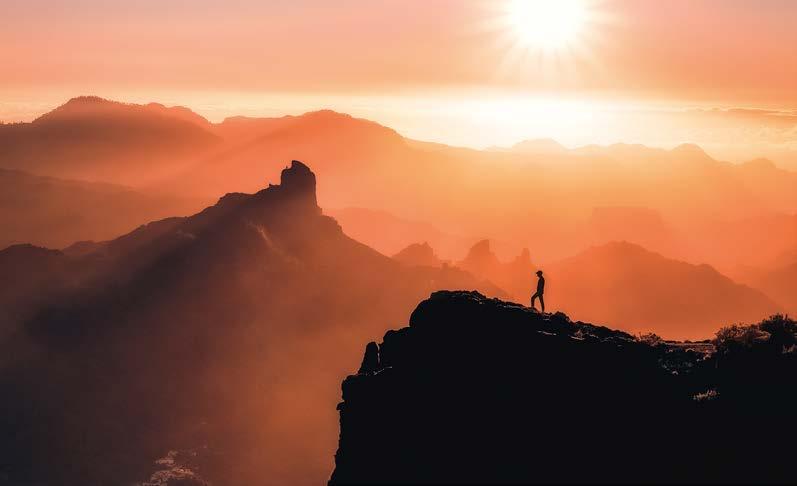
A data intelligence system which improves tourism competitiveness in Gran Canaria, aimed at tourism professionals on the island.
The Tourism Intelligence System of Gran Canaria (SITGRAN), is an open tourism data system created to foster improvements to the industry and the decision-making of our companies and public administrations.
The system is comprised of more than 40 sources, both public and private, which are made fully available to the industry through interactive visualisations and open-use files.
It offers the possibility of learning what they are like, what is of interest and how those who visit Gran Canaria see the island in a dynamic, simple and accessible way.
Data are available in reports divided up into different categories:
Tourist behavioural habits
Range of tourist offers
Connectivity
Resources and Climate
what they are like what is of interest how they see Gran Canaria
Gran Canaria’s tourism companies and services maintain a constant commitment to excellence.
The destination is part of the project to improve the quality of destinations promoted by the Secretary of State for Tourism and the Spanish Federation of Municipalities and Provinces. The Integral System of Tourism Quality in Destinations (SICTED for its acronym in Spanish) assesses the good practices in the course of the activities of up to 37 different trades related to the tourist experience and visitor satisfaction
Currently, 204 companies from 37 different sectors in Gran Canaria are affiliated with the SICTED program, which recognizes their commitment to quality and are present in tourist resorts and the interior of Gran Canaria, increasing tourist satisfaction and promoting customers loyalty. Establishments and their services are committed to the destination and to their guests through a homogeneous quality service, taking care of the small details and the environment, with a will to continuously improve.
The island’s heritage, as a place of passage for travellers, is reflected in the open, cosmopolitan and multicultural character of the island. Cities and towns with more than 500 years of history reflect the colonial architecture and centuriesold traditions that mark a resoundingly Atlantic identity. Gran Canaria’s tourist offer is as varied as the island itself. Its charming attractions include its natural environment, its “living history”, its cultural and festive activities, all of them manifestations of its own unique identity.
Archaeology in Gran Canaria: the island stands out, especially, for its rich and varied archaeological heritage, highlighting different manifestations associated with the habitat of its first settlers, their rites and economic activity. These include Troglodyte settlements dug out of the cliffs, necropolises and villages of a proto-urban character that are examples of a cultural universe, where engravings and cave paintings are also of great interest. The Network of Archaeological Sites of Gran Canaria highlights all this legacy of the prehistory of the islands.
Architecture in Gran Canaria: the architectural heritage is made up of highly valuable buildings and the old neighbourhoods in its towns and

An example of this is its home-grown sports:
• Canary wrestling
• Vela Latina Canaria sailing discipline, a sport from the archipelago with strong roots in the capital of Gran Canaria.
• Shepherd’s leap
• Stone lifting and heaving
• Plough lifting
• Stick game
• Stick fighting Cattle dragging
To access the full list of museums, please click on the link below:
villages, including Vegueta in the island’s capital city, and the examples of domestic and religious architecture in Agüimes, Telde, Arucas, Guía, Agaete and Teror. There are also cave houses that are part of important troglodyte settlements in municipalities such as Artenara, Gáldar, Guía and Agaete.
Art in Gran Canaria: the island is home to a truly impressive legacy that includes Flemish works from the 15th and 16th centuries, the Baroque, with Luján Pérez at the forefront, the 19th and 20th century ‘-isms’, with Néstor Martín-Fernández de la Torre as a leading exponent, through to the most advanced native art championed by Manolo Millares and international figures such as the ”sculptor of the wind” Martín Chirino.
Ethnography in Gran Canaria: the islanders’ human activity, reflected in their trades and traditions, is one of the most interesting values of ethnographic heritage here. Agricultural landscapes, tools, hydraulic devices, mills, salt and wine all come together in this regard, along with immaterial elements in the form of customs, traditions and festivities that represent the peculiarity of Gran Canarian society and the essence of its identity as a people.
The history of Gran Canaria is on display in its extensive network of museums in which the cultural symbiosis of the island is all mixed together. Pre-Hispanic mummies, ancient ships, contemporary art, together with great writers, painters, musicians, as well as representations of the island’s architecture, aboriginal ceramics and sculpture complete a wide range of spaces in which to go deep into the island’s history and culture.
The must-see museums are:
• Columbus House Museum
• Museo Canario Canary Museum
• Elder Science and Technology Museum
• Atlantic Modern Art Centre (CAAM)
• Pérez Galdós House Museum
• Néstor Museum
• Painted Cave Museum and Archaeological Park
• Martín Chirino Foundation of Art and Thought – Castle of La Luz
The handicrafts of Gran Canaria are a living example of the union of tradition, history, and culture, embodied in the dedicated work of the craftsmen and craftswomen.
Their products transmit the value of our heritage and our signs of identity and provide a lasting souvenir of any visitor’s trip. Their creations can also be found in the FEDAC shops, which offer a seal of guarantee of authentic craftsmanship, “made in Gran Canaria”.
Check the full list of FEDAC stores here:
The climate and the privileged natural environment come together to make Gran Canaria an impressive year-round open-air gym for sports enthusiasts. On the sea or in the mountains, the island is always the best option for engaging in sporting pursuits. The island is regularly chosen by professional teams from all over Europe to hold their training sessions, especially in the winter months, and offers the perfect place to combine sport, rest and leisure. The island boasts great facilities and highly qualified professional services to meet the needs of sportsmen and women.
Gran Canaria is a true paradise for sea enthusiasts and sea-related activities.
The warm sea water temperature, ranging from 18°C in winter to 22°C for the rest of the year, along with sports port infrastructure and optimal sea and wind conditions, allows for water sports to be practiced in any season.
The island is surrounded by the sea, with 128 beaches, so there are endless possibilities for water sports and activities. It is an ideal place for surfing, windsurfing, bodyboarding and kitesurfing, with some of the best waves in this part of the world, perfect for sailing, deep sea fishing, open water swimming, and all the fun of leisure activities by the sea and sea excursions.
The seabed around Gran Canaria also deserves a special mention, a territory under the sea that amazes divers with its richness, perfect for snorkelling and diving.
This is complemented by a wide range of infrastructures, including six sports marinas, and services: diving, surfing, windsurfing and kitesurfing schools, physical activity trainers, specialised medical care, gyms and recovery centres.
The mountainous areas of Gran Canaria are perfect for sportsmen and women, be they professionals or amateurs, for hiking, climbing, mountain biking, road cycling, trail running and canyoning, and much more. These places inspire visitors to get up close to nature and to experience great adventures.
The island offers a multitude of routes for lovers of cycle touring, combining inland landscapes with coastal routes.
Lovers of hiking and nature have a very special date every year at the Gran Canaria Walking Festival, where hikers from all over the world come together to discover the emblematic landscapes of the island, its culture and centuries-old traditions.
One of the top attractions is to follow the Camino de Santiago (Saint James’ Way) de Gran Canaria, the only Jacobean route recognised outside the mainland, which crosses the island from south to north. It runs for 65 km, packed full of history, starting from the emblematic Faro de Maspalomas lighthouse and finishing up in the city of Gáldar, where the Holy Gateway to the Church of Santiago de Los Caballeros awaits tired legs.
A round of golf in Gran Canaria is more than just a sport, it is a tradition that has its origins in 1891, the year in which the Real Club de Golf de Las Palmas, a pioneer in Spain, was founded. The course offers a unique experience just 15 minutes from the city and 25 minutes from the airport, situated at an altitude of 400 m, on the edge of the Bandama Caldera, a Protected Natural Area, an example of more recent volcanic activity in Gran Canaria.
It offers comprehensive and comfortable facilities, together with all the services for golfers and their playing partners, and close to uniquely built-in accommodation thanks to luxurious hotel complexes.
The island has magnificent courses dotted throughout its territory, designed by elite professionals:
• Real Club de Golf de Las Palmas
• Maspalomas Golf
• Meloneras Golf
• Anfi Tauro Golf
• Salobre Golf & Resort - The New Course
• Salobre Golf & Resort - The Old Course
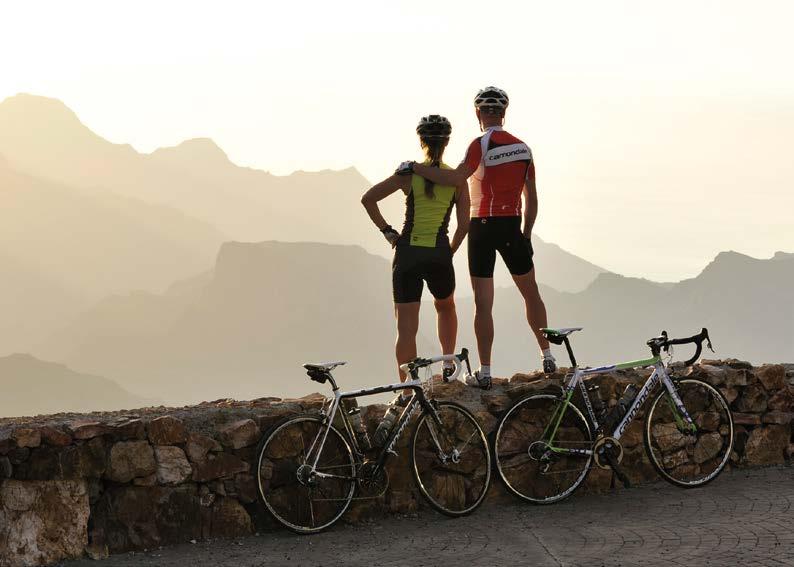
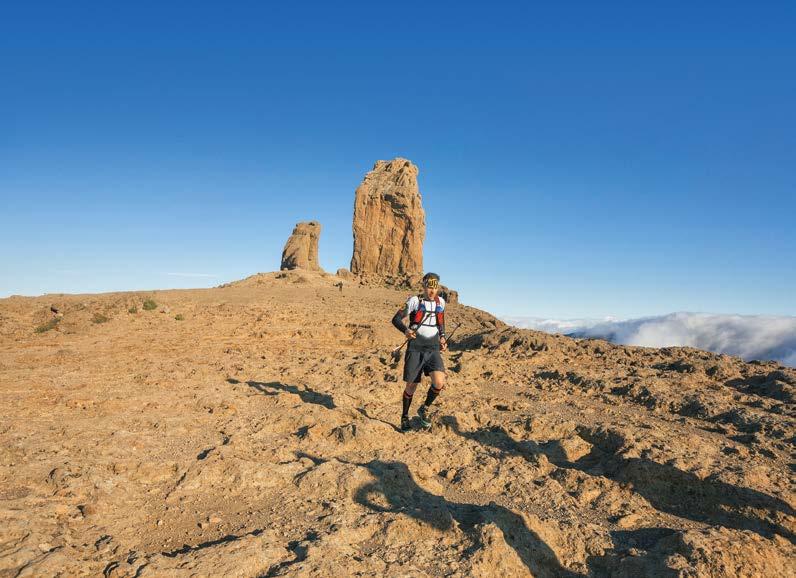
The island hosts a large number of sports competitions such as the Gran Canaria Windsurf World Cup, the Transgrancanaria, and the LALIGA FC FUTURES Tournament. These events highlight the special natural conditions of the destination and the preparation of its professionals and companies that host and organise all kinds of sporting competitions.
The combination of sport and tourism is yet another of the island’s strong points and an outstanding product within this industry.
The disciplines listed below are just a few examples of the numerous sporting events that Gran Canaria plays host to. The calendar runs throughout the year and features top international tournaments, world championships and deeply-rooted local activities that have sport as the main protagonist. Added to these are activities such as training camps for elite European athletes and teams, who use the island as their favourite destination for fine-tuning and preparation before they tackle the year’s main competitions.
• The North Face Transgrancanaria
• Epic Gran Canaria
• Free Motion - Desafío la Titánica
• Anfi Challenge Mogán Gran Canaria
• Dunkerbeck GPS Speed Challenge
• Rally Islas Canarias
• Fred. Olsen Express Transgrancanaria Bike
• Sand Series Classic ITF BeachTennis Gran Canaria
• Gran Canaria SwimRun Maspalomas
• Artenara Trail
• Rally de Maspalomas
• LPA Surf City No Limit
• Open LPA Surf City
• Gran Canaria PWA Windsurfing Grand Slam
• GWA Wingfoil World Cup Gran Canaria
• Gran Canaria Air Battle Air & Wind
• Aguas de Teror Trail Desafío los Picos
• Gran Canaria Air Battle Kite & Wing Foil
• ITF W100 DISA Gran Canaria
• Open Internacional Pesca de Altura Gran Canaria
• Open Water Maspalomas
• Rafa Nadal Tour Gran Canaria
• LPA City Race
• Gran Canaria Frontón King
• ETB Gran Canaria Pro Body Board
• Beyond The Coast Sky Gran Canaria
• Gran Canaria Walking Festival
• Gran Canaria Yellow Bowl
• Binter NightRun
Las Palmas de Gran Canaria
• Regatas ARC y ARC+
• 360º The Challenge Gran Canaria
• Gran Canaria Bike Week
• Gran Canaria Bestial Race
• Gran Canaria Pro-AM SUP (Stand Up Paddle)
• Gran Canaria O-Meeting
• San Silvestre Las Palmas de Gran Canaria
• Torneo LALIGA FC FUTURES
Check here the agenda of events in Gran Canaria:
The island has a network composed of 30 offices distributed throughout the island, manned by 45 qualified tourist information clerks who provide assistance to visitors and help them discover every corner of Gran Canaria.
Total visitors to Tourist Information Offices in 2024: 179.382 Origin
Non-resident Canarians on the islands Resident Canarians on the islands
Visitors to Tourist Information Offices by nationality 2024
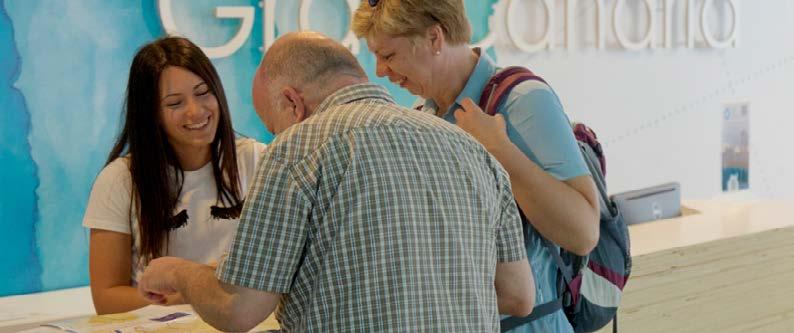
MICHELIN GUIDE
14 restaurants included in the 2025 Michelin Guide
5 Michelin-starred restaurants, including one with the only Michelin Green Star in the Canary Islands and the only one to hold both recognitions in the archipelago
Bib Gourmand: 1
Recommended: 8
2 Repsol Suns: 1
1 Repsol Sun: 11
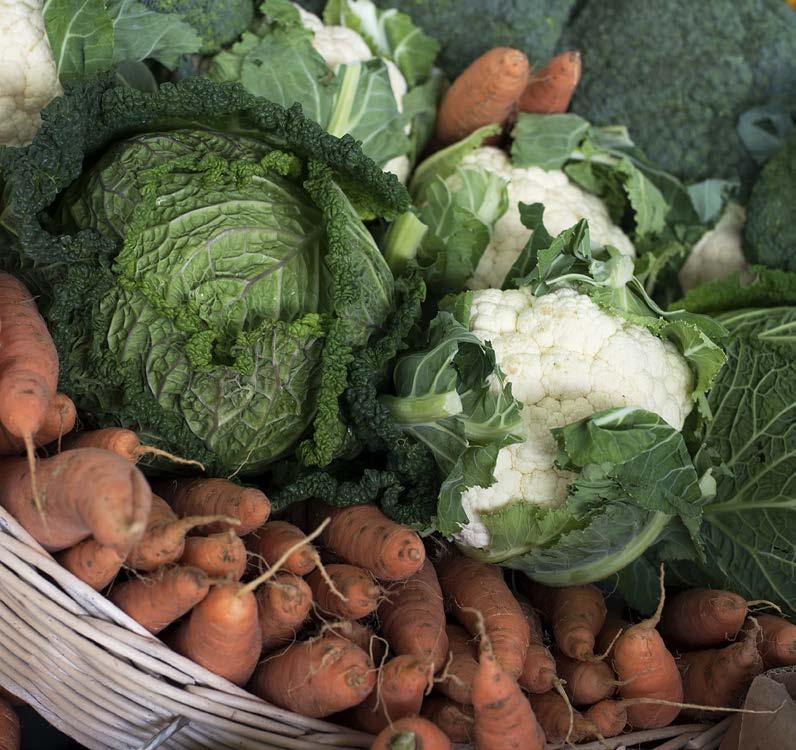
The island offers a recipe book containing a mixture of flavours and cultures that oozes its own identity. It ensures the quality of products from Gran Canaria, all blended in together by the hands of young chefs who are revolutionising the island’s cuisine, and packed full of nuances.
The island’s unique Atlantic setting, with its mild temperatures and volcanic natural surroundings, result in a unique local product. Based on the roots of the Gran Canarian culinary tradition, the island’s kitchens are more on fire than ever, and have become a real attraction for travellers who are looking to use their palates as a means to getting closer to the authentic essence of the Canary Islands.
Cheese - culinary experiences at the Gran Canaria Cheese Tour
Wine - the Gran Canaria Wine Tour
Coffee 100% locally grown, cultivated in the Valley of Agaete
Rum - made at one of Europe’s oldest distilleries
Added to this list of gastronomic gems are sea salt, oil, tropical fruits, gofio cornmeal, fish, almonds, marzipan and sweet bienmesabe, all of which are a revelation for the senses.
Chefs, restaurants, sommeliers, winemakers, cellar masters, chefs and local food producers are coming together to show their commitment and responsibility towards the culinary inheritance they have received. These professionals are making it possible for Gran Canaria’s gastronomy to be at its brilliant best right now.
Gran Canaria has been part of the Saborea España brand since 2017. This has resulted in a much higher profile for the exceptional island raw materials and the establishments that make up its culinary offer, the quality of its chefs and the endless possibilities offered by its local produce.
The Michelin Guide 2025 awards have reconfirmed the revolutionary transformation of Gran Canaria’s cuisine in recent years, led by chefs who have managed to give a new value to the rich heritage of local products. The island’s gastronomic proposal has consolidated itself as a major attraction of the destination, where vanguard and tradition combine perfectly to create a cuisine with its own personality and unique flavors.

Gran Canaria is now a reference in the audiovisual industry, both in film production and television and advertising. This industry is an economic activity with the capacity to consolidate the industrial fabric and the generation of specialised employment.
The Gran Canaria Film Commission is the organisation in charge of promoting the island abroad as a natural film set with an endless list of advantages.
The Canary Islands currently offer the most powerful tax incentive system for film and audiovisual production in Europe. Based on the economic and fiscal regime (REF) of the Canary Islands, validated by Spanish and European national legislation, the archipelago enjoys its own special legal and fiscal framework, which means that film productions benefit from the following tax deductions.
Excellent fiscal incentives
Up to 54% - 45% direct deduction for international productions
Up to 50% - 45% deduction for investments in Spanish productions or co-productions
OTHER FISCAL BENEFITS
0% - 7%
Canary Indirect Tax rate (IGIC) 4%
Company tax (ZEC) – start up ZEC companies in the Canary Islands
Gran Canaria is
6.000 m2 160 4.700 m2
Total built-on surface area Solar panels 2 backlots + parking
Perfect locations for filming productions in a “continent in miniature” with strong landscape contrasts, at a short distance from each other and easily connected by road.
• Coasts and beaches
• Deserts
• Rural and colonial environment
• Urban environment
• Infrastructures
• Unique locations
• Mountains and forests
• Film sets
• Private properties
Gran Canaria hosted a total of 29 productions in 2023:
• 7 series
• 15 feature films
• 4 documentaries
• 13 digital animation series
• 1 digital animation feature film
Gran Canaria is also
The island offers unique tax incentives, comparable to those for film production, for this economic activity related to special effects, animation and video games.
The island has become the new benchmark for animation. It is the venue for the Animayo Festival, which will celebrate its 20th anniversary this year, an international event that focuses on new technologies, bringing together international artists, producers, engineers and creators. Animayo is the first and only festival in Spain to be designated a “Qualifying Festival” by the Academy of Motion Picture Arts and Sciences in Hollywood for the Oscar® Awards in the animation category.
The Gran Canaria Studios complex covers a total built area of approximately 6,000 m², consisting of two studios: one of 1,800 m² and a new one of 1,200 m² dedicated to virtual production with LED screens. It also includes all necessary facilities for production development, such as workshops, dressing rooms, warehouses, offices, and parking. These professional studios for indoor filming complement the diversity of outdoor settings and locations available on the island.
Las Palmas de Gran Canaria, the most cosmopolitan city with the largest economy and most dynamic culture in the Canary Islands, is the Archipelago’s urban destination par excellence. Co-capital of the Canary Islands, the latest annual census data place it as the ninth most populated city in Spain with a population of 380,436. It is a diverse and contrasting destination, featuring elements of a business centre, a city open to the sea and cosmopolitan life with manageable dimensions where everything is close at hand.
It is the European capital of the mid-Atlantic and represents a cultural and economic bridge between Europe, Africa and America.
The city also boasts one of the best climates in the world , thanks to its exceptional location, next to the Tropic of Cancer, and the trade winds that blow in from the north of the Atlantic. The average annual temperature in the capital of Gran Canaria is 22 degrees Celsius , which makes it a truly privileged location.
There is a wide-ranging and varied accommodation offer, the latest additions being small boutique hotels, together with shopping centres, restaurants, terraces and rooftops open to the city skies, plus promenades and avenues next to the sea and one of the best urban beaches in the world, Las Canteras Beach.
These all slot in neatly to forge a capital city that is open for business, a place that offers all kinds of services, enabling visitors to experience every nook and cranny. The city boasts five centuries of history, a place of passage for three continents, with a colonial past reflected in its oldest neighbourhood, the historic district of Vegueta, an ideal place to stroll through cobbled streets, discover
its Columbus-style architecture and end up in the Calle Mayor de Triana, the city’s main open-air shopping area which, in turn, brings together the most representative examples of Canary Island modernist architecture.
The civil society of Las Palmas de Gran Canaria, supported by public institutions in Gran Canaria, is currently working towards the common objective of promoting this candidacy, which would acknowledge the importance of the historical, cultural, artistic and urban values of the historic centre of the capital, a meeting point between the two worlds that were united thanks to the voyages of Christopher Columbus.
Since the 1980s, the Carnival of Las Palmas de Gran Canaria, declared a Festival of National Tourist Interest, has achieved great notoriety, with acts of great popular participation. Nowadays, a large number of activities and events complement a festival that has the Gala de la Reina, the famous Gala Drag Queen, and the competitions of “murgas” or “comparsas” as its most deeply rooted and attractive events.
The Carnival is one of the major events of the year in the capital of Gran Canaria, not forgetting others held in the south of the island, and is an internationally renowned festival much enjoyed by locals and visitors alike.
Of its museums, the following stand out:
• Columbus Museum
• Pérez Galdós House-Museum
• Museo Canario
• Néstor Museum
• Elder Science and Technology Museum
• Atlantic Modern Art Centre (CAAM)
• Castillo de Mata City and Sea Museum
• Diocesan Sacred Art Museum
The aquarium is a leisure infrastructure that opened in 2017 and covers 12.000 square metres, containing no less than 35 different aquatic ecosystems and hundreds of species on view in the spectacular glass windows and inners passageways. After dark, the building features striking night-time lighting that evokes the silhouette of marine animals. The aquarium, which takes its name from one of the most representative pictorial works of the Gran Canarian modernist artist Néstor MartínFernández de la Torre, is located in El Puerto de Las Palmas de Gran Canaria and is open every day of the week.
Las Palmas de Gran Canaria has an attractive range of rooftops and terraces at the top of buildings where visitors can unwind with a drink any time of the year while enjoying unrivalled views of the city.
Located mostly in some of the best hotels in the Gran Canarian capital, and in areas like the Historic Complex Vegueta-Triana, Las Canteras Beach, or Parque Santa Catalina, their leisure proposals cover hours and activities to enjoy the city with the best climate in the world almost around the clock.
The following link provides a list containing a selection of these open air locations, with the following notable options:
• La Azotea de Benito Cocktail Bar –Monopol shopping centre
• Alis Rooftop & Cocktail Bar, Royal Hideaway Santa Catalina
• Rocktop La Peregrina, Boutique Hotel Cordial La Peregrina
• Rooftop & Terrace Aloe, Hotel Aloe Canteras
• El Tendedero de Catalina, Tusity Bed & Chic Las Palmas

Gran Canaria is a great MICE destination, an island that holds major events, a paradise to be enjoyed from coast to coast. The destination offers meeting planners multiple opportunities for holding all kinds of reunions and celebrations. It guarantees good weather, is a nearby destination with good communications, modern infrastructures and a landscape of strong contrasts. It is one of the most traditional tourist destinations in Europe, with a wealth of organisational experience.
The Gran Canaria Convention Bureau is the official brand of Gran Canaria Tourism, whose purpose is to drive the promotion of the MICE sector on the island and to offer services for organising congresses, conventions and incentive trips.
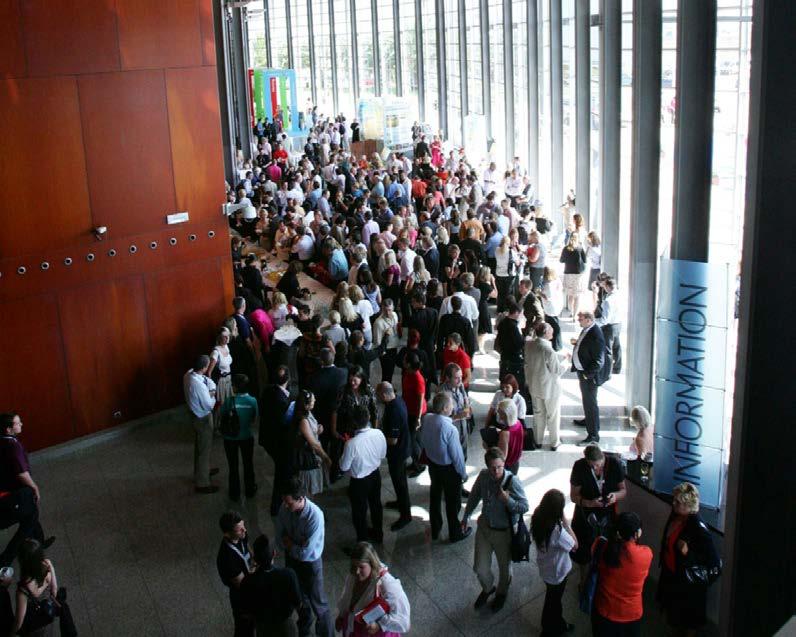
The island has a large number of specialised companies and professionals dedicated to audiovisual material, assembly, furniture, digital printing, transport and translation. They ensure that all the logistics are under control from start to finish.
Gran Canaria offers locations that add a unique touch to events. These range from the interior of a cave house to colonial haciendas, coffee plantations, banana plantations, gabinetes literarios stately buildings and the lighthouse next to the Maspalomas Dunes.
Maximum travelling distances never exceed 80 km, making it possible to organise incentive trips that can cover several different climates in a single day, from golden sands to a volcanic crater or a snowy summit. The island is an outstanding destination for winter meetings with outdoor sports or incentives related to golf or nautical activities, thanks to its mild temperature 365 days a year, where visitors can combine working days with leisure and relaxation.
Gran Canaria has three high performance and fully-equipped conference centres. Two of them are located in the island’s capital, Las Palmas de Gran Canaria, and the other one is in the tourist resort of Maspalomas-Meloneras.
01
Palacio de Congresos de Canarias
Alfredo Kraus Auditorium
Located next to Las Canteras Beach, the centre offers 14 meeting rooms with a capacity for 3.465 participants.
02
Palacio de Congresos de Gran Canaria
Infecar Feria de Gran Canaria
Its facilities cover more than 35.000 m2, with a capacity for more than 2.000 people and nine multi-purpose halls.
Expomeloneras Convention Centre
This centre is located in the south of Gran Canaria, just a few metres from the Maspalomas Dunes. It is a multifunctional building covering 14.000 m2, with 24 conference rooms, a surface area of 9.264 m2 and a hall of 4.000 m2 for complementary activities.
Other quality venues include:
• Columbus Museum
• Gabinete Literario
• Centro de Iniciativas de la Caja de Ahorros de Canarias (CICCA)
• Paraninfo at the University of Las Palmas de Gran Canaria
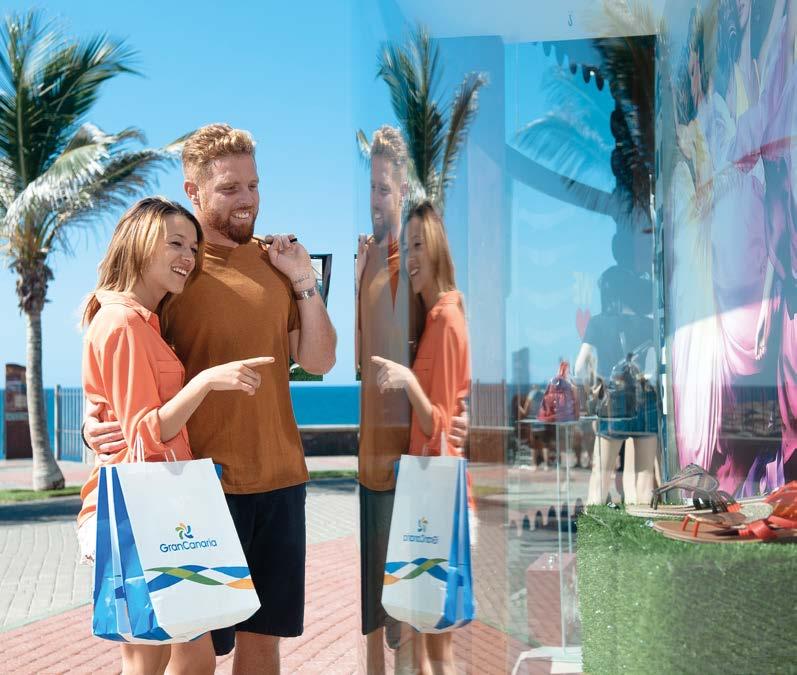
Economic and fiscal benefits
TAX FREE
Articles purchased in Gran Canaria are exempt from VAT and special taxes of the European Union, only 7% IGIC is applied. The territory’s low tax rate allows prices to be between 10% and 30% lower than in the rest of Europe. Perfumes, cosmetics, tobacco, alcohol, electronic devices and vehicles are all very competitively priced on the island. The sun and the good weather make the island a wonderful all-year-round destination for shoppers.
Visitors can choose between:
01 INDOOR SHOPPING CENTRES
offering the best services and comforts, with the most prestigious international, national and Canary brands
02 OPEN AIR SHOPPING CENTRES
Outdoor spaces located all over the island.
03
TRADITIONAL MARKETS
Dotted around charming towns and villages.
Gran Canaria is the favourite holiday destination for many families from all over Europe because it has everything they need to enjoy their holidays with their children. There are endless leisure, fun and entertainment options on offer any time of the year to meet the expectations of all ages. In our small continent there are always fun activities going on, a place where visitors can enjoy an amazing holiday experience, discovering archaeological, ethnographic, artistic and natural treasures of worldwide importance. In addition, the destination boasts a wide variety of theme parks, water activities, fair rides, museums, different options to combine with days on the beach or in the stunning natural surroundings of its unknown interior.
The island offers a wide variety of programmes and treatments for wellness and health care with plenty of services to choose from, all in advanced facilities dedicated to offering a complete revitalisation of body and mind. It has the
most comprehensive thalassotherapy and spa centres, offering a way to round off a holiday or short break by adding moments of disconnection and relaxation all within in an ideal climate all year round. In addition, Gran Canaria is positioned as a competitive medical destination with experienced professionals and cuttingedge technology.
Gran Canaria is one of the major LGBTQI+ tourism centres in Europe. With more than 60 years of history linked to the LGBTI community, it is a true international reference point for the group. The island’s climate and beaches have always been a source of attraction, but its libertarian spirit and respect for diversity have also contributed to this positioning. In addition to this, there is a powerful and varied LGTBI tourism offer, with historic sites in Maspalomas and Playa del Inglés. Some of the most important European-wide events for the group are held every year here, such as Maspalomas Gay Pride and the Maspalomas International Carnival, and the Drag Queen Gala, one of the essential and most important events at the Las Palmas de Gran Canaria Carnival.
Gran Canaria has a thousand different ways to ensure visitors have non-stop fun, especially in the great outdoors, all year round. Its fine climate is an open invitation to enjoy the terraces, some of them by the sea, pubs or discos, whether in the tourist areas of the south, with the Paseo de Meloneras, Playa del Inglés or Puerto Rico at the forefront, or in the capital, Las Palmas de Gran Canaria, which offers different atmospheres with bars in the historic centre of Vegueta-Triana or in the Port area. Popular festivals are held throughout the year, such as the Almond Trees in Bloom Festival held in several municipalities, which almost overlap the carnival season, and in summer other major celebrations are held all over the island, notably ‘el Charco’, ‘la Rama’, ‘la Vará del Pescado’, ‘la Traída del Agua’ and ‘el Perro Maldito’.

Juan Rejón Año is the founder of El Real de Las Palmas, the first city outside of the European continent to be governed by the Castilian kingdom with Isabel and Fernando, the Catholic King and Queen, at the helm.
English corsair Sir Francis Drake suffers defeat in his attempted assault on the Muy Noble y Muy Real Ciudad de Las Palmas, the name with which the current capital of the island, Las Palmas de Gran Canaria, was founded.
his
Gran Canaria thus witnessed the greatest adventure in history, the discovery of the New World, and became a bridge between three continents.
Creation of the University of Las Palmas de Gran Canaria (ULPGC), the university with the largest number of students in the Canary Islands, with more than 20,000, and one of the leading universities in Spain. It stands out as a tourism research centre, currently led by the University Institute of Tourism and Sustainable Economic Development (TIDES).
The year in which Fuji, the first Japanese restaurant in Spain, opened.
Gran Canaria plays a part in the first moon landing at the Maspalomas Space Station, through the meticulous and decisive monitoring of the Apollo 11 spacecraft, created in 1942 by NASA.
Birth of the great novelist Benito Pérez Galdós in the emblematic neighbourhood of Triana.
Heroic defence by the inhabitants of Gran Canaria as they repel the siege of the capital by the Dutch sailor Pieter Van Der Does.
A royal order declares the land and maritime facilities that were to be built in Gando (Telde) to be turned into a national airport. The first passenger flight took place in 1933 and in 1935 this route became the Madrid-Canary Islands flight route.
In December, a plane from the Swedish airline Transair AB, carrying 54 passengers, landed in Gando, an event that would mark the consolidation of the island as a leading holiday destination, initiating a new era for Gran Canaria in terms of tourism.
Establishment of free ports in the Canary Islands, a special economic regime that improved trade relations in the archipelago by means of tax exemptions and free trade facilities. Construction of the Azuaje Spa, which signalled the start of tourism in Gran Canaria. The island’s mineral-medicinal waters led to the arrival of pioneering tourists who came to enjoy the island’s volcanic natural surroundings and excellent climate.
The Alfredo Kraus Auditorium opened its doors on 5th December. Since then, the auditorium, which bears the name of the most international Canarian tenor, has become a leading light for culture in the island’s capital city.
beach was inaugurated on 25th November.
On 29th June Gran Canaria is awarded the status of World Biosphere Reserve by UNESCO.
On 8th May, the Estadio Gran Canaria was inaugurated, replacing the historic Estadio Insular, built to host the matches of Unión Deportiva Las Palmas football club.
This was the decade in which the Port of La Luz became the main port of the archipelago, a time when its activity increased and commercial and social ties with the British intensified, leaving their mark on the city and also contributing to the origin of tourist activity.
Celebrated British writer Agatha Christie moved into the Hotel Metropol (now the headquarters of the Las Palmas de Gran Canaria City Council), one of the most select hotels of the time, built and run by the British, where she wrote “The Companion”, set in Gran Canaria.
El 15 de marzo se inaugura el pabellón polideportivo Gran Canaria Arena, siendo la sede del Campeonato Mundial de Baloncesto de ese año
Reopening of the Pérez Galdós Theatre on 14th April, following its refurbishment and extension. The theatre was declared an Asset of Cultural Interest since 1994, in the category of Monument, and since 1902 it has borne the name of the great Gran Canarian novelist following the roaring success of the premiere, in 1901, of his play “Electra”.
On 7th July UNESCO declares the Cultural Landscape of El Risco Caído and Las Montañas Sagradas de Gran Canaria a World Heritage Site.
Gran
is
the ‘Biosphere Destination’ certificate for sustainability.
In 2025, Gran Canaria Tourism Bureau celebrates half a century of legacy since the establishment of the island’s promotional entity (1975–2025) under the slogan “50 Years, One Destination, One Future.”
The autonomous public organization, created by the Cabildo de Gran Canaria, is dedicated to safeguarding the island’s tourism interests, which form the backbone of its economic development. Over five decades, its activities have been guided by a commitment to maintaining Gran Canaria as a top-tier tourist destination by directing, planning, and implementing policies aligned with evolving market trends.
Gran Canaria Tourism Bureau, officially renamed from the “Patronato de Turismo de Gran Canaria” (Gran Canaria Tourism Board) in late 2021, plays a pivotal role in positioning the island at the forefront
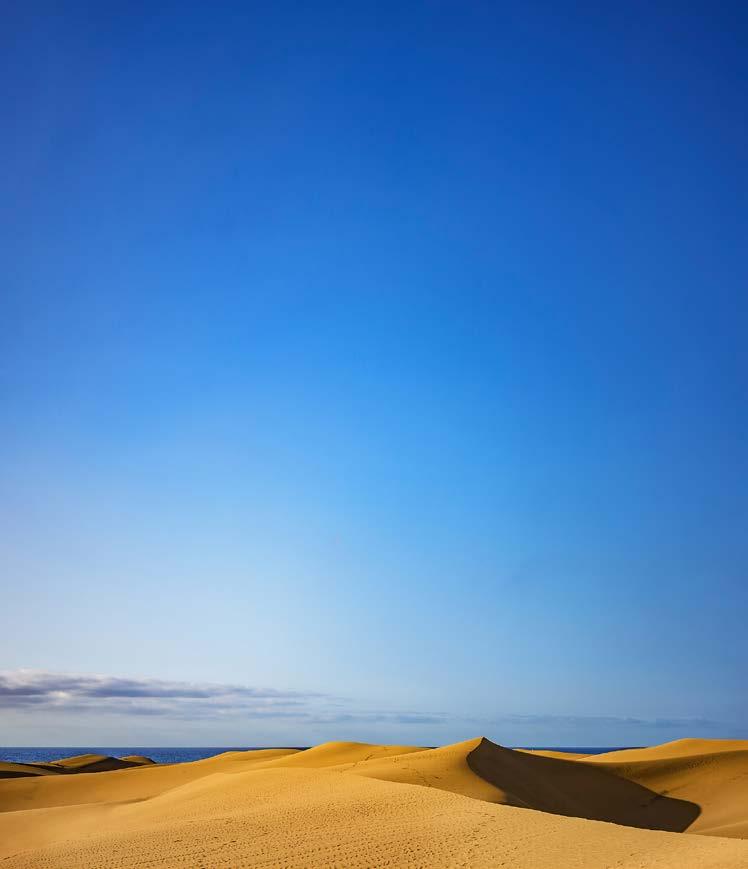
of 21st-century tourist destinations. It manages the complexities of Gran Canaria’s primary industry alongside the private sector. Sustained growth in hospitalityrelated economic activity has led to recordbreaking tourist arrivals year after year. This growth also brings increasing challenges, prompting the institution to plan for the sector’s future in close collaboration with its entire value chain.
The organization has also embraced its commitment to transforming Gran Canaria’s tourism model to meet modern travelers’ demands. This adaptation aims to ensure that the destination remains a leader in Europe while continuing its economic and social development. The belief that tourism can drive change toward sustainability underpins this effort. Its strategy focuses on three pillars of sustainability—socioeconomic,
environmental, and territorial—aligned with the United Nations’ 17 Sustainable Development Goals (SDGs).
In addition to pursuing greater sustainability, Gran Canaria Tourism Bureau works to enhance the destination’s competitiveness through digitalization and innovation across all areas of the sector. It fulfills its role as a destination marketing organization by promoting Gran Canaria internationally, continuously improving the destination, and managing public aspects of the island’s tourism system. In recent years, it has intensified direct collaboration with local businesses as part of its strategy to strengthen excellence and maintain Gran Canaria’s international standing as a premier destination.